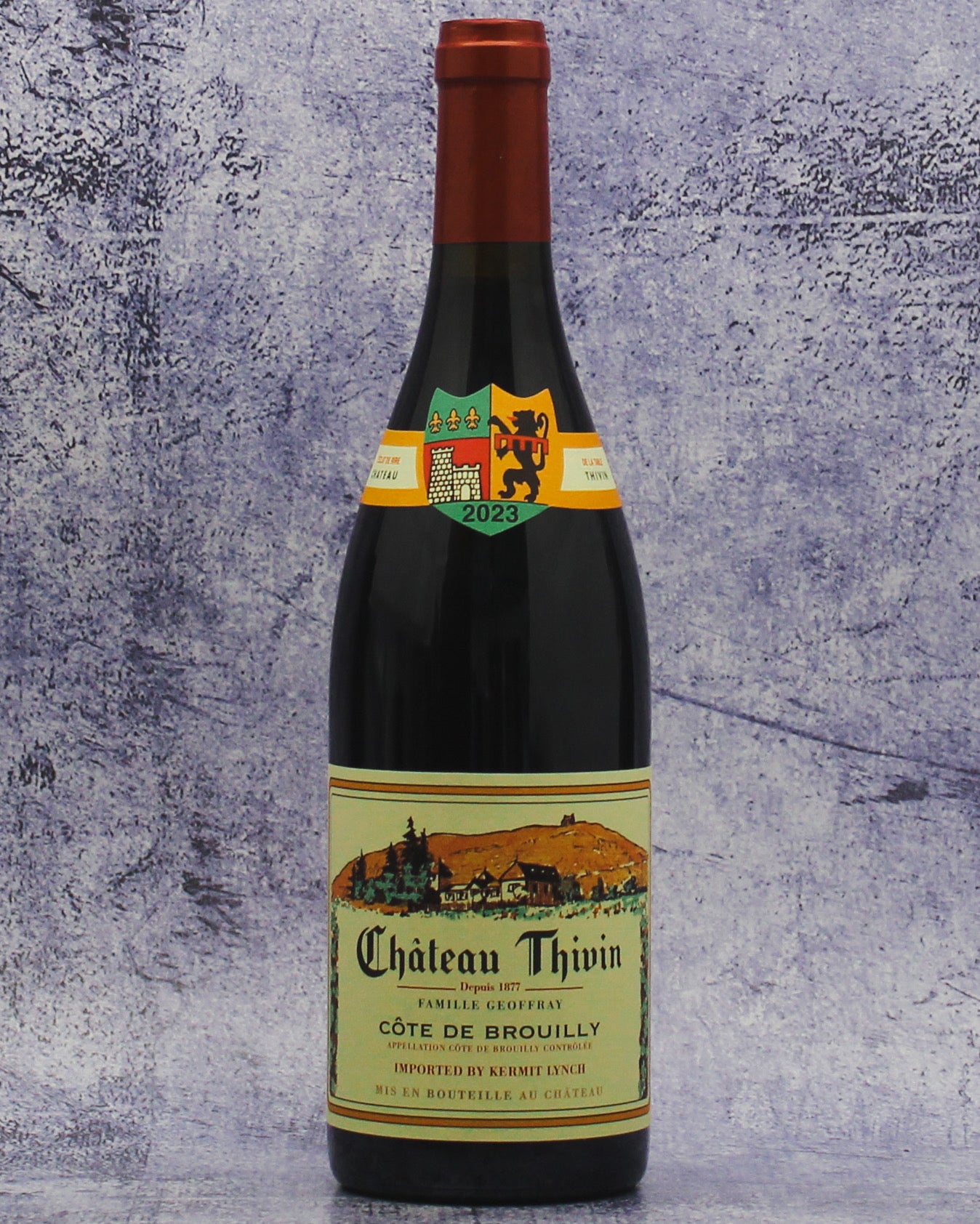Description
From: Beaujolais, France
Varietal: Gamay
Taste: Côte de Brouilly wines are concentrated and elegant, with floral characters, and are less earthy than their Brouilly counterparts. Château Thivin’s Côte de Brouilly—an old-vine blend evoking succulent cherries and black tea, from the best plots on Mont Brouilly’s southern side—is about as fine and age-worthy a bottle as you can find anywhere. While this wine is showing off lovely, ripe red and black berry fruit, hallmark minerality, and a smattering of pepper, this is absolutely a wine that you could age (with proper storage) for 5-10 years.
Pairing: A good match with old-fashioned chicken-liver gateau, pâté or meat / poultry dishes in sauce, such as duck magrets or duck confit. Other lovely pairings include serving this wine alongside Bayonne ham (or charcuterie in general), dishes centered around sausage (like the recipe we’re sharing below), BBQ/grilled chicken, pork chops, veal chops, Pot au Feu (Beef Pot Roast), roasted chicken, anything with mushrooms, fall risotto’s or pastas (sans tomato), and of course, more casual takeout like gyros, carnitas or adobadas tacos, lamb/beef/bean burgers, and even hearty fish like salmon.
Roasted Sausages With Grapes and Onions
By Melissa Clark
About. Château Thivin, overview. Wine lovers who experience is limited to Noveau owe it to themselves to try the other side of Beaujolais, the hillside Beaujolais, where the soils are more granite and the terrain more rugged. The name Beaujolais may not be present of the label; instead one will find the village name, such as Brouilly, Cote de Brouilly, Morgan or Fleurie.
Chateau Thivin is located in the Cote de Brouilly, an ancient volcanic mound which juts unexpectedly from the Beaujeu Valley floor, about 30 miles north of Lyon.
In the heart of Cote de Brouilly, on the south-facing, crumbling granite slopes, Claude Geoffray at Chateau Thivin works twenty acres of vines. The vineyards are planted entirely to Gamay Noir a jus blanc, a variety of Gamay that is cultivated to stand free of wires and stakes, sturdily attached to the hillside by deep-seeking roots.
At Chateau Thivin, each section of the vineyard is harvested and fermented separately, to preserve the characteristic differences afforded by variations in exposure and altitude. The final wine is a selected blend of these cuvees. Traditional whole cluster fermentation is used in order to keep the characteristic fruity qualities of Gamay, after which the grapes are put into cuve by gravity without being crushed or destemmed. Each vintage spends a few months in large oak foudres before bottling.
An expanded view. Many thanks to importer KLWM for the following information! It is no surprise that Château Thivin is the benchmark domaine of the Côte de Brouilly; everything about it is exceptional. Built in the fifteenth century on an ancient volcano which juts out steeply into the valley below, Thivin is the oldest estate on Mont Brouilly. Even more important, however, is its tremendous success since farmer Zaccharie Geoffray purchased the château with its two hectares of land at auction in 1877. His son Claude expanded the property over the next few decades, and his son, also named Claude, boosted the prestige of the zone in the face of the Great Depression when he played a pivotal role in the creation of the Côte de Brouilly appellation. With his wife Yvonne, he also helped to bring greater recognition to the entire region with the establishment of the Maison du Beaujolais in 1953. Over the years the family continued to promote the appellation, receiving many influential artists and journalists at the château. The French novelist, Colette, wrote admiringly of her visit to Thivin, for example. In 1976, Richard Olney took Kermit to visit on their first wine trip together. It was Olney’s top recommendation in the whole of the Beaujolais region. The current generation of the Geoffray family continues their tradition. Today their grandnephew Claude, his wife Evelyne, and their son Claude-Edouard continue the tradition as staunch and proud defenders of the terroir of the Côte de Brouilly.
Thivin’s Côte de Brouilly parcels are predominantly south-facing and are planted entirely with Gamay vines that average 50 years of age. The soil is plowed and composted regularly while cover crops are left between some rows to encourage microbiotic activity. Absolutely no insecticides are used. On a slope with a grade of 48% and crumbly surface, implementing these techniques is essential to safeguard the soil from erosion, but it isn’t easy! Each section of the vineyard is harvested and vinified separately to preserve the unique characteristics afforded by variations in exposure and altitude. Even the estate’s vineyards in the Brouilly appellation are planted on a moderately steep hillside of decomposed pink granite, while most of the appellation is planted on the flat valley floor. Traditional whole-cluster fermentation keeps the characteristic fruity qualities of Gamay, after which the grapes are transferred to cuves by gravity without being crushed. Each vintage spends a few months in large oak foudres before bottling. The resulting wines, according to Kermit, resemble “…a country squire who is not afraid to get his boots muddy. Handsome, virile, earthy, and an aristocrat.”
Viticulture/Vinification
In 2008, the domaine began a conversion to organic viticulture that will be finished around 2020
• Biodiversity is achieved by placing hay around the edges of the vineyards and herbs and flowers are planted between rows
• Natural composts serve as a natural fertilizer
• Regular plowing aerates the soils
• All grapes are harvested by hand, in mid-September
• All parcels undergo separate vinifications
• Gravity-fed fermentation cuves
• Traditional whole-cluster vinifications
This wine. Côte de Brouilly:
• Vineyards situated on steep slopes with a 48% grade
• Exposed to the South, East, and Southeast
• Fermentation lasts from 6-12 days
• Ages in oak foudres for six months before bottling
• Drinks well in its youth and develops beautifully 3-8 years after the vintage

